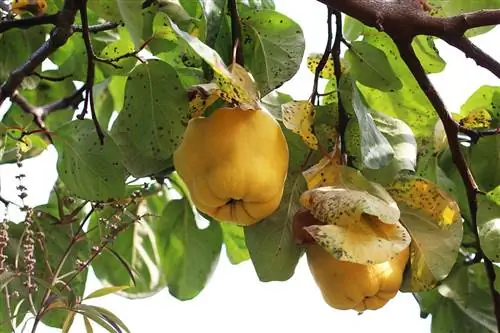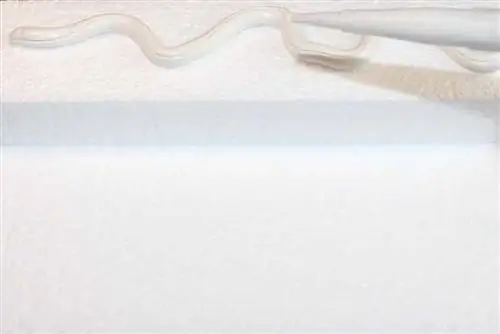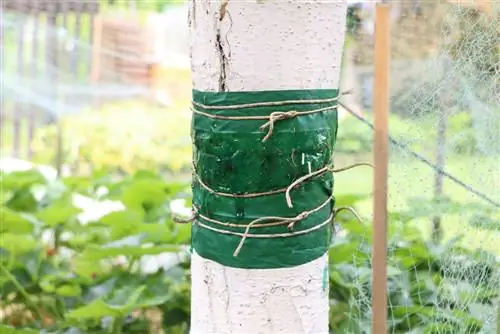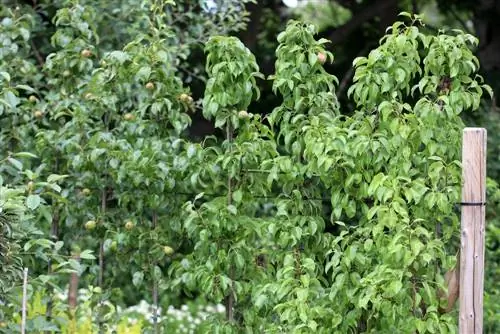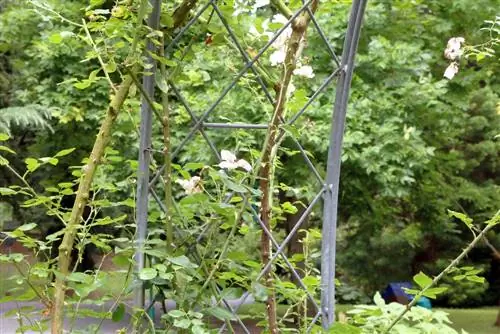- Author admin [email protected].
- Public 2023-12-17 03:39.
- Last modified 2025-01-24 12:45.
Glue rings are always forgotten, which is because the pests that they are mainly used to combat only become large-scale every few years or even decades. Once the large and small frostbites “manage” mass propagation, some garden owners will soon wish that they had installed glue rings in a timely manner. Read below about when “timely” is and why you can use the glue rings to keep bare fruit trees in the middle of the warm season can prevent:
The frost moth's baldness
The glue rings were once invented to protect fruit trees from being completely stripped bare by the small frost moth “Operophtera brumata” or the large frost moth “Erannis defoliaria”. For good reason: the small frosted moth is the species from the butterfly family of peepers that occurs most frequently in our country, and the large frosted moth is not exactly rare either; Both live in deciduous forests and bushes, but also like to live in parks and orchards. Both butterflies emerge from their pupae lying in or on the ground in autumn. Usually from the end of September, typically after the first nights of frost, this is how they got their name. However, frost is not a prerequisite for hatching, so control should start a little earlier in autumn.
Female frost moths have no wings, but they have long legs that they use to climb up the nearest tree or bush that is close to where they hatch. The male butterflies can fly, they sit on fallen leaves or on tree trunks during the day and are active from dusk and through the night; they want to find females for the purpose of reproduction. The name only comes from the hatching process, the butterflies do not prefer to fly in sub-zero temperatures, but prefer to fly on mild November or December nights; only at dusk and in the second flight phase from midnight. It is also the warm winter evenings on which the glow of a flashlight reveals hundreds of butterflies in suitable biotopes, while in the frosty periods of the flight season only “sitting around” butterflies can be observed. Anyone who has found a female reproduces, then the females lay the eggs on branches or in cracks in the bark, where they overwinter.
Next spring the horror begins: just in time for the leaves to emerge, the light green caterpillars hatch and begin to spread in the surrounding area as small frost moths. To do this, the newly hatched caterpillars, like the young spiders in Indian summer, spin individual, long threads on which they let the wind carry them around (the biologist says they drift). Very successful and very far, frost moths appear unexpectedly on high-rise building balconies, on islands in the middle of lakes and rivers and in other strange places where a frost moth has never been seen before - and this wind swing is also an ingenious transport instrument for completely destroying a fruit tree plantation in a flash colonize.
There the caterpillars now spin webs in the buds and between the young leaves that protect them from predators and get started: They eat everything green that comes in front of their chewing tools, young leaves and buds and entire shoot tips, if they “do it really colorfully”, only the stronger leaf veins and stems remain; If enough caterpillars have landed on the same tree, the baldness will cover every branch of the still beautiful green fruit tree.
The large frost moths, on the other hand, are more of a minor problem; Hatching, walking up the tree trunk, mating etc. is similar to that of the small frost moth, but the caterpillars of the large frost moth stay on “their tree”. There the yellow-red to brown-red patterned caterpillars eat leaves and fruit buds from April to June. However, they do so in peace and quiet, because whenever there is a disturbance they are carried to the ground on a spider thread, which they then climb back up “when the coast is clear again” (the thread is then folded up and cleaned up). Both caterpillars eat until it is time to pupate. Then they gently sink to the ground on the tried and tested “spider threads” and pupate into a web on the ground.
After the infestation is before the infestation, even if not immediately
An infestation with frostbite moths, especially the small frostbite moth, is extremely dangerous, and yet the threat is repeatedly forgotten by hobby gardeners because the mass proliferation of frostbite moths occurs “in fits and starts” (not in fruit growing, this is already the case Infestation with 3-4 caterpillars per 100 flower clusters as a damage threshold above which action is taken).
In the spring of 2005, entire orchard slopes around Schorndorf in Baden-Württemberg were stripped of their leaves; in the spring of 2014, there was an impressive denudation of early-growing deciduous trees in some areas of Austria; After these mass proliferations, glue rings can be seen again on the fruit tree trunks the following autumn.
A little too late, if it really hits a tree, it will be permanently weakened; There is no need to fear a mass influx in the spring following a clearing, because the caterpillars have deprived themselves of their food source. As soon as the trees recover, the caterpillars are ready; That's why you shouldn't wait until there are a lot of frost moths again and remember the good old tradition of glue rings on the tree in good time:
Glue rings against frostbite
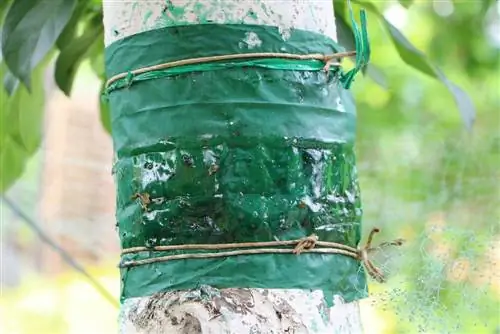
Since the females of these nocturnal butterflies are flightless, the actually very simple glue traps are effective control measures.
The long-proven, biological pest control does not use poison, is environmentally friendly and does not harm the tree in the slightest. If the glue rings are attached correctly, which works like this:
- Glue rings must be attached at the end of September/beginning of October at the latest
- Ready-to-use glue rings consist of approximately 10 cm wide strips that are already filled with glue
- There are also pre-made paper glue rings that are coated with a special (non-drying) caterpillar glue
- The glue application should be approximately 2 mm thick, the female frostbite will not stick to thinner glue
- Heavier glue application usually starts to flow when the tree is exposed to sunlight
- In addition, birds that peck off the stuck insects would eat too much of the glue
- You can also buy caterpillar glue that can be applied directly to the tree trunk in a ring shape
- However, this option can be quite a lot of work if the infestation is severe, see tip below
- The glue on the rings should always be green or tree-colored, white glue rings attract too many beneficial insects
- The glue ring must be attached very close and very firmly to the trunk
- Because for the female butterflies crawling up, it's about the survival of the species, they put in a lot of effort to get to their goal
- You can simply crawl under loosely attached glue rings
- Experienced fruit tree owners therefore additionally attach the glue rings with binding wire
- A ring of glue around the trunk is not always enough, a supporting tree post would be climbed in the same way
- So this also needs to be protected, just as side shoots that almost reach the ground need to be tied up
- Check glue rings occasionally, adhering dirt or leaves will affect the effectiveness at some point
This simple biological “weapon” is impressively effective in that it prevents the female frost moths from climbing the trunk, “celebrating their wedding” high up in the crown and laying their eggs there a short time later.
Tip:
As always, the retail trade willing to sell has come up with many variants around the glue ring, many types of ready-to-use combinations, several craft variants and penetrating glues that can be applied directly to the tree bark, which are intended to save a lot of work. As is so often the case, it's worth sticking with the originally developed original, because people in the past weren't stupid and thought something of it when they applied the glue to paper and not directly to the trunk. Firstly, the amount of work saved during application is not very great; after application, not only the ring sticks around the tree, but also the gardener and many parts of his tools; Ready-made glue rings are much easier to handle. In addition, a fully stocked glue ring must be removed so that as few of the females stuck to the glue as possible are mated or the eggs of the females mated on the glue have no chance of hatching. The trunk under the glue ring should then be brushed briefly to destroy any eggs laid under the glue ring. But that's nothing compared to the work it takes to "pick off" female frostbite moths that are stuck directly to the trunk.
Make your own glue rings
It's not financially worth it with a few fruit trees in the garden: 25 m of caterpillar glue belt paper costs €7, 0.25 l of caterpillar glue costs €10, 24 m of paper-coated binding wire costs €8, for €25. - € so most gardeners are well equipped for the next few years. If you look after or own an orchard, it could be worth it, but the natural tree resin rosin costs around €25 per kilo.
A real motivation for homeowners to make glue rings themselves comes from the look: Green glue rings do not look “chic retro” in every environment, but sometimes just look boring, allotment-like. Rosin, on the other hand, is a balsam resin that is obtained from trees and therefore looks good with trees. It is available in restorers' supplies, music stores and artists' supplies in various light to darker tones. With the other ingredients in the following recipes you can make a glue mixture that exactly matches the bark of the trees that are in your field of vision when you sit in the garden. Any organic wrapping paper that is strong enough and can be cut to the appropriate length can be used as paper for the glue ring.
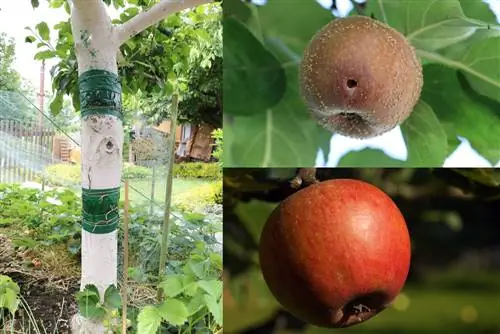
There are many old recipes for making tree glue; Here is a selection, the ingredients of which can be found with reasonable effort even today:
Olive oil tree glue
- 100g rosin
- 60g olive oil
- 20g turpentine
Wood tar tree glue
- 700 grams of wood tar
- 500 grams of rosin
- 500 grams of brown soft soap
- 300 grams of Tran
Rapeseed oil tree glue
- 2500 grams of rapeseed oil
- 200 grams lard
- 200 grams of turpentine
- 200 grams of rosin
Mix each one together and stir until you get a smooth mixture (works best in warm weather in the sun).
Glue rings also help against other pests
With the practical glue rings you can prevent the following other woody pests from crawling up tree trunks:
- Ants (Lasius sp. etc.) like to create aphid colonies high up in the tree, which could become a problem in weakened trees
- Apple web moth (Yponomeuta malinellus), “the frost moth for Malus species”, the most common of which is the apple tree (Malus domestica) in the garden, can become a serious pest if there are no natural enemies in the area
- Bloodlice (Eriosoma lanigerum), can cause bloodlice cancer (tissue growths) on apple trees, quinces and rarely on some other woody plants
- However, only old, weakened trees and trees suffering from a lack of nutrients or over-fertilization are at risk
- Hazelnut bud borer (Curculio nucum), occasionally eats the leaves of hazel species (Corylus) and drills into young nuts
- Unequal wood borer (Xyleborus dispar) etc. Bark beetle, attacks many tree species, weeping trunks (in early spring or from the second half of July) and tiny boreholes are indicators of infestation
- Snow moth (Apocheima pilosaria), similar to the frost moth, damages various deciduous trees
- Common earwig (Forficula auricularia), the actually very useful “soil producer” can cause soft fruits such as sweet cherries, peaches and apricots to rot if it climbs the tree when it is ripe
- Glue rings against peepers etc. only keep ants and aphids away if they are back on the tree in March
Super tip
Glue rings are practical, helpful and inexpensive, but there are much better biological pesticides: that do not have to be purchased and installed, maintained or cleaned, all day long and completely free. These “insider tips” are called blackbirds, thrushes and sparrows, or chalcid wasps, parasitic wasps and caterpillar flies; They love nothing more than feeding fat caterpillars to their children and they always move into a garden on their own if it is designed to be close to nature. Even in such gardens there is sometimes a longer-lasting, stronger infestation with caterpillars or leaf-sucking lice, e.g. B. as a result of unusual weather conditions. But you don't need to worry about this infestation, it will take care of itself in a relatively short period of time. Every time you use a chemical poison, you permanently disrupt these self-regulating forces of nature until one insecticide use follows the next.


